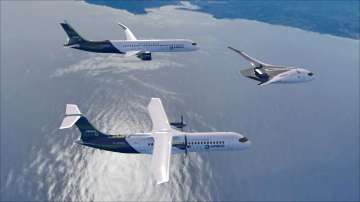This week Airbus, the biggest name in aerospace after Boeing, revealed three concepts for the world’s first zero-emission commercial aircraft which could enter service by 2035. A hydrogen fuel-cell plane that’s capable of carrying passengers completed its maiden flight this week, Flightradar24 reported.
Though Airbus is also pursuing battery-powered aircraft, hydrogen is increasingly emerging as a more promising fuel. That’s because hydrogen has a much higher energy density than today’s batteries.
The company is currently working on three seperate concept designs for hydrogen-powered aircraft equipped with zero-emission technology, which can reduce aircraft’s emissions by up to 50%.
The designs, named ZEROe, differ in size and style, but are all meant to be zero-emission, using hydrogen as their primary source of power.
Turbofan engines:
They include an aircraft that would use turbofan engines and carry between 120 and 200 passengers. With a range of more than 2,000 nautical miles, it would be powered using what the company described as “a modified gas-turbine engine running on hydrogen, rather than jet fuel, through combustion.”
Turboprop engines:
Another design, using turboprop engines, would also be powered using modified gas-turbine engines, have a range of over 1,000 nautical miles, but carry fewer passengers.
Blended-wing body:
A third design offers a radical vision of how airplanes could look in the years ahead. Carrying as many as 200 passengers, the “blended-wing body” concept would see wings “merge” with the aircraft’s main body.
“I strongly believe that the use of hydrogen – both in synthetic fuels and as a primary power source for commercial aircraft – has the potential to significantly reduce aviation’s climate impact,” Airbus CEO Guillaume Faury was quoted as saying in a statement by CNBC.
“These concepts will help us explore and mature the design and layout of the world’s first climate-neutral, zero-emission commercial aircraft, which we aim to put into service by 2035,” he added.
Not just Airbus, many working on zero-emission aircraft projects:
There are dozens of other companies, many of them small, working on zero-emission aircraft projects around the world. Some are still wild concepts, while others are more practical and well into their development process.
READ Flightradar24.com report
MagniX, a small aerospace firm with its headquarters in the Seattle area, has been testing an electric engine fitted to a de Havilland DHC-2 Beaver seaplane – with promising results so far.
And last week the company announced it too would be exploring the potential of hydrogen. That move is in partnership with hydrogen fuel provider Universal Hydrogen, which is developing a hydrogen fuel retrofit kit for the De Havilland Canada DHC8-Q300.
Latest Business News
